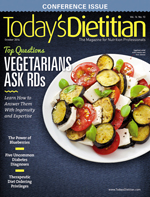
October 2014 Issue
Choosing the Right Cookware
By Toby Amidor, MS, RD, CDN
Today’s Dietitian
Vol. 16 No. 10 P. 10
Q: Can you provide an overview of available cookware, and which items I should recommend to my clients?
A: With so many cookware choices available, it can be overwhelming for any shopper. Educating clients about cookware can help take the guesswork out of selecting it and help them make healthier and safer choices. Here are the pros and cons for the most popular options available.
Nonstick
This cookware is easy to use and clean, making it popular. It also doesn’t require much oil or butter, helping to decrease calories and fat in the dish being cooked. However, some studies have found a link between nonstick cookware and an increased risk of certain types of cancer.1 Nonstick cookware contains the chemical perfluorooctanoic acid (PFOA), which can be released if temperatures are too high (500° F or above). PFOA also has been associated with an increased risk of high cholesterol levels and infertility.2,3
Another issue is that the nonstick coating can wear away with hard use, and pieces can chip off into the food. However, the FDA has determined that neither the particles nor the fumes released at high temperatures pose a health hazard.4
Uncoated cookware, on the other hand, may be a good choice if you do plenty of braising and browning, but it’s much tougher to clean.
Copper
Copper pots and pans are a great heat conductor and are perfect for range-top cooking (eg, delicate sauces). Home cooks appreciate copper pots’ beauty, but these items are expensive and require polishing. Copper cookware typically is lined with tin or stainless steel (in more modern copper cookware). The FDA warns against using unlined copper cookware since the metal easily can leach into acidic foods, causing copper toxicity.
Aluminum
Aluminum pots (eg, Dutch ovens) are made from cast aluminum. They’re inexpensive and resist rust and corrosion. However, aluminum easily scratches and dents, and reacts with acidic food, so it isn’t highly recommended.
Anodized aluminum hardens the surface of the cookware making it nonstick, resistant to scratches, and easy to clean. It also seals the aluminum, so it doesn’t leach into food or react with acidic food. There’s some concern, however, that once the surface has been worn down, aluminum may then leach into food.
Stainless Steel
Stainless steel is a combination of iron and other metals. It’s affordable, durable, and scratch-resistant, making it a popular selection for consumers. It’s also resistant to rust and corrosion. Stainless steel doesn’t conduct heat well unless it’s made with an aluminum or copper core. Manufacturer’s instructions should be followed carefully when cleaning to avoid scratching.
Cast Iron
Great heat conduction and durability has kept cast-iron cookware around for hundreds of years. It’s also affordable and can be recommended for more frequent use to clients with iron-deficiency anemia. Cast iron, however, is heavy and requires regular care to prevent rusting.
Other Considerations
• Glass lids: These allow you to see inside your pot without having to lift the lid (which lets steam escape). However, they’re heavy and can break.
• Handles: Metal handles can go from stovetop to oven, so you can use fewer pans. Solid metal handles are sturdy but bulky to handle. Plastic handles won’t get hot, but they usually can’t be used in the oven. Silicone handles don’t get hot and can go in the oven up to a certain temperature (check the manufacturer’s instructions).
• Utensils: Metal tools can scratch cookware, and plastic utensils can melt. Wooden spoons and silicone spatulas help preserve cookware while keeping food safe.
— Toby Amidor, MS, RD, CDN, is the founder of Toby Amidor Nutrition (http://tobyamidornutrition.com) and author of the cookbook The Greek Yogurt Kitchen. She’s also a nutrition expert for FoodNetwork.com and contributor to US News Eat + Run.
References
1. Kontou N, Psaltopoulou T, Soupos N, et al. The role of number of meals, coffee intake, salt and type of cookware on colorectal cancer development in the context of the Mediterranean diet. Public Health Nutr. 2013;16(5):928-935.
2. Eriksen KT, Raaschou-Nielsen O, McLaughlin JK, et al. Association between plasma PFOA and PFOS levels and total cholesterol in a middle-aged Danish population. PLOS ONE. 2013;8(2):e56969.
3. La Rocca L, Alessi E, Bergamasco B, et al. Exposure and effective dose biomarkers for perfluorooctane sulfonic acid (PFOS) and perfluorooctanoic acid (PFOA) in infertile subjects: Preliminary results of the PREVIENI project. Int J Hyg Environ Health. 2012;215(2):206-211.
4. FDA Food Code 2009: Annex 3 - Public Health Reasons / Administrative Guidelines - Chapter 4, Equipment, Utensils, and Linens. FDA website. http://www.fda.gov/food/guidanceregulation/retailfoodprotection/foodcode/ucm189212.htm. Accessed August 4, 2014.
